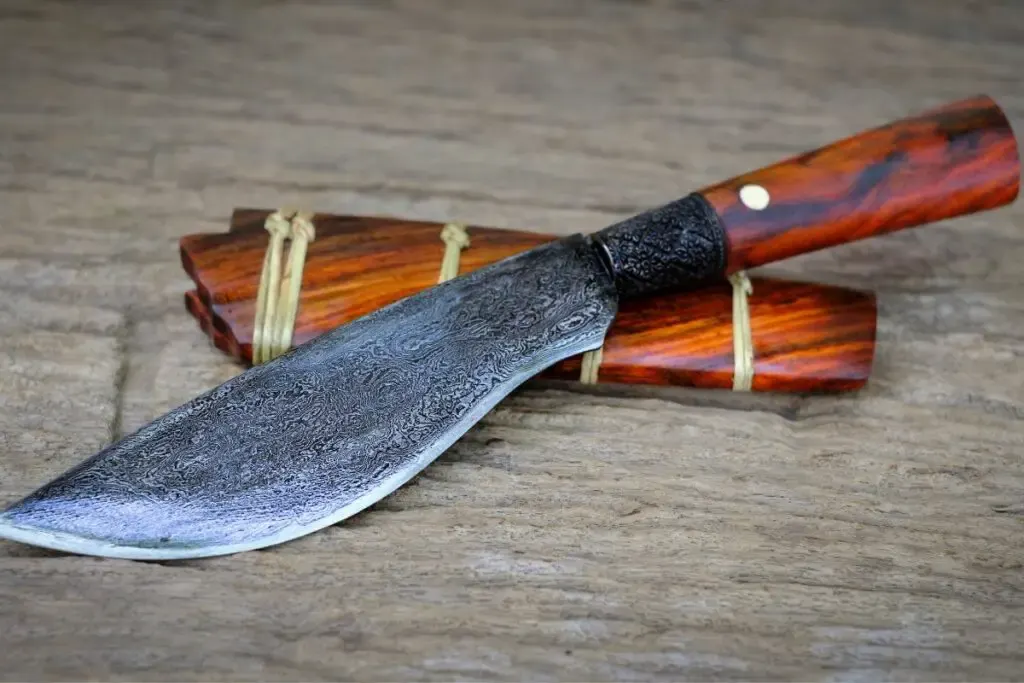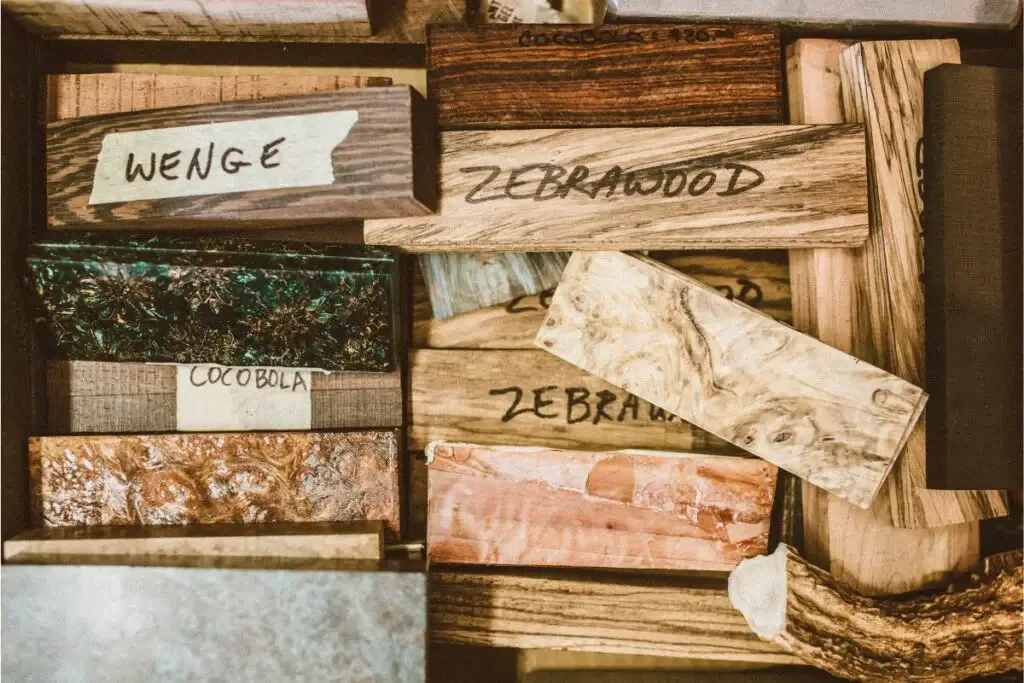As an Amazon Associate, we earn from qualifying purchases with no additional costs for you.
When choosing or making a knife, one aspect that often gets overlooked is the handle, specifically, the material it’s made from. While the blade might be the star of the show, the handle plays a crucial role in the overall aesthetics and performance of the knife. It’s not just about how the knife looks but also how it feels in your hand, its balance, and how it withstands the test of time. This raises the question of what wood is best for knife handles.
The best wood to use for knife handle scales is dense wood with a fine grain structure. These characteristics provide durability to the knife handle, resistance to contamination, and wear and tear. Maple Burl, Hickory, Walnut, Ebony, and Teak are examples of the best wood for knife handles.
Wood brings natural beauty to the knife’s handle, but some woods are better than others for this function. We will investigate this aspect and explore the best types of wood to use, the factors to consider when choosing your wood, and how different types of wood fare in different knife scenarios. Whether you’re a knife maker, a culinary professional, or a knife enthusiast, this information will help you understand and appreciate the art and science behind choosing the right wood for your knife handles.
Did you know you can source wood for knife handle scales online? Amazon has a wide selection of wood types available for creating knife handles. Check the Ebony wood scales here. (Amazon Link)
Best Wood For Knife Handle Scales

Wood stands out as a popular choice for knife handles among the various materials available.
It’s not only about its natural beauty and the unique character it lends to each knife but also about its practical attributes. But with a myriad of wood types available, how do you decide which one to use for your knife handle?
Wood is one of my favorite choices for handle material on a knife, especially because of the natural beauty the wood brings to the knife.
Wood has many advantages when used as a knife handle, but the right type of wood must be used to produce the durability necessary for a knife handle.
The Importance of Choosing The Right Knife Handle Material
The knife handle, often overshadowed by the blade, holds significant importance in a knife’s overall functionality and aesthetics. The handle material, in particular, plays a pivotal role in determining the knife’s performance, longevity, and appeal.
The handle is where you interact with the knife, influencing your control, precision, and comfort during use. Therefore, the knife handle material is not a choice to be made lightly. It’s a decision that impacts the knife’s balance, grip, and overall feel in your hand.
Various materials are available for knife handle scales, ranging from synthetic materials like plastic and rubber to natural ones like bone, horn, and of course, wood. Each material has unique properties that can enhance or detract from the knife’s performance and aesthetics.
Among these, wood has long been a favored choice for knife handles. Its natural beauty, warmth to the touch, and the unique character it lends to each knife are hard to match.
But not all woods are created suitable for the role of a knife handle. The type of wood used can significantly influence the handle’s durability, comfort, and maintenance needs.
Choosing the best types of wood for knife scales requires understanding the factors that make certain woods more suited for knife handles than others.
TIP: If you are interested in buying a Japanese knife, we recommend these knives (Amazon links):
- Santoku: Yoshihiro NSW Hammered Damascus Santoku
- Gyuto: Yoshihiro VG-10 Hammered Damascus Gyuto
- Nakiri: Yoshihiro Hammered Damascus Nakiri
Aspects To Consider When Choosing Wood For Knife Handles
Choosing the right wood for your knife handle involves more than just picking the one that looks the most appealing. Several factors come into play, each contributing to the handle’s performance, durability, and aesthetics.
The following are the key considerations to bear in mind for wood knife handles.
- Durability. The wood should be strong enough to withstand the rigors of use without cracking or splitting. Hardwoods are generally more durable than softwoods and are often preferred for knife handles.
- Comfort. The handle should feel comfortable in your hand. The wood should be smooth and not cause any discomfort or blisters during prolonged use.
- Aesthetics. The wood’s color, grain pattern, and texture can significantly impact the knife’s overall look. Some wood’s naturally beautiful grain can make your knife stand out.
- Maintenance. Some woods require more care than others. For example, certain types of wood may need regular oiling to prevent drying out and cracking.
- Cost. The price of the wood can vary greatly. Exotic hardwoods can be quite expensive, while local hardwoods are generally more affordable.
The following table compares some commonly used woods for knife handles.
| Wood Type | Durability | Comfort | Aesthetics | Maintenance | Cost |
| Maple Burl | High | High | High | Medium | High |
| Cherry Wood | Medium | High | High | Low | Medium |
| Oak | High | Medium | Medium | Medium | Low |
TIP: Did you know that the wooden handles on Japanese knives can be replaced? Read our article on how to do this to add new life to your Japanese kitchen knives!
7 Simple Steps: How To Replace A Japanese Knife Handle
Best Types Of Wood For Knife Handles

There are several standout choices for selecting the best types of wood for knife scales. Each type of wood brings its unique characteristics to the table, influencing not only the aesthetics but also the performance and feel of the knife. Let’s explore each of these woods in more detail:
Maple Burl For Knife Handles
Maple Burl is a hardwood known for its spectacular grain patterns, which can add a touch of luxury to any knife handle. Its high durability makes it a practical choice as well.
However, the irregular grain that gives Maple Burl its beauty can also make it a challenging material to work with. It’s also on the higher end of the price scale, reflecting its unique qualities and the demand among woodworkers and knife makers.
Cherry Wood For Knife Handle Scales
Cherry Wood is a well-balanced choice offering good durability and a beautiful reddish-brown hue that deepens with age.
It’s a medium-density wood, making it relatively easy to work with. However, Cherry Wood may require regular maintenance to maintain its color and prevent the wood from drying out.
Oak Wood As Knife Handle Material
Oak is a classic choice known for its high durability and affordability. It’s a dense hardwood, which contributes to its strength and longevity.
While it’s relatively easy to work with, Oak’s grain pattern is not as pronounced or attractive as some other woods, which might be a consideration if aesthetics are a priority.
Ebony For Knife Handles
Ebony stands out for its extreme hardness and dark, almost black color. This makes it a highly durable choice and one that adds a striking contrast to the metallic sheen of a knife blade.
However, Ebony is one of the most expensive woods due to its density and the slow growth rate of Ebony trees. The rarity of the wood can also affect its availability in some areas.
Walnut For Knife Handle Scales
Walnut is sought after for its rich, dark color and straight grain, making it a visually appealing choice for knife handles. It’s a durable hardwood that’s moderately easy to work with.
Walnut can range in color from light to dark brown, offering various aesthetic options and a range of visual effects for the knife handle.
Hickory Wood For Knife Handles
As one of the hardest, heaviest, and strongest American woods, Hickory is a solid choice for knife handles. Its toughness translates into excellent durability, but it can be challenging to work with due to the hardness of the wood.
Rosewood For Knife Handles
Rosewood is a popular selection for knife handles due to its beautiful color and grain. It’s a dense and resilient wood that stands up well to wear and tear. However, Rosewood is becoming less available due to export restrictions and conservation efforts, which has driven up its price.
Teak For Knife Handles
Teak is renowned for its exceptional resistance to decay and moisture, making it an excellent choice for outdoor knives.
The high oil content in Teak gives it a natural sheen and helps to preserve the wood. However, Teak’s hardness can make it challenging to work with, and it is also on the higher end of the price scale.
Cocobolo For Knife Handle Scales
Cocobolo is a tropical hardwood known for its striking colors and patterns. It’s a dense and durable wood that’s resistant to decay.
The downside is that Cocobolo can be difficult to work with due to its density and natural oils, and it’s also relatively expensive.
African Blackwood
African Blackwood is an extremely dense and durable wood often used in high-end knives. It’s known for its dark color and fine texture. African Blackwood is one of the most expensive wood types and can be challenging to work with due to its extreme hardness.
Here’s a comparison table of these woods:
| Wood Type | Durability | Workability | Aesthetics | Availability | Cost |
| Maple Burl | High | Low | High | Medium | High |
| Cherry Wood | Medium | High | High | High | Medium |
| Oak | High | High | Medium | High | Low |
| Ebony | High | Medium | High | Low | High |
| Walnut | High | Medium | High | High | Medium |
| Hickory | High | Low | Medium | High | Medium |
| Rosewood | High | Medium | High | Low | High |
| Teak | High | Low | High | Medium | High |
| Cocobolo | High | Low | High | Medium | High |
| African Blackwood | High | Low | High | Low | High |
BTW: If you are interested in buying the best cutting board, you can find our recommendations below:
- The best overall: Virginia Kitchen Boys Cutting Board (Amazon link). This fantastic cutting board is made from sustainable walnut wood from the United States and brings almost perfect safety when cutting with your knives.
- Alternative: Yoshihiro Cutting Board (Amazon link). Professional traditional Japanese cutting board that chefs around the world use.
- Cheaper option: Shun Cultery Cutting Board (Amazon link). Another Japanese cutting board stands out, especially for its simplicity and affordable price.
TIP: Keeping your knives clean and sanitized is as important as sharpening, preventing rust, and storing your knives correctly. Find out how to clean and sanitize your knives in our article below:
Knife Care: When & How To Clean & Sanitize Your Knives
Woods Commonly Used For Knife Handles

Beyond the best types of wood for knife scales, several other kinds of wood are commonly used for knife handles due to their unique properties.
These commonly used woods are often selected for their availability and their lower cost to keep the overall costs of the knife down.
The following woods are commonly selected as knife handles for these reasons.
- Birch Wood. Birch is a light-colored wood with a fine grain, making it a popular choice for knife handles. It’s relatively easy to work with and is quite durable. However, it may not have the same visual appeal as some of the more exotic woods.
- Ash. Ash is a strong, elastic wood often used in tool handles, including knives. It’s relatively easy to work with and has a straight grain that can be quite attractive. However, it’s not as durable as some other woods and may require more maintenance.
- Pine. Pine is a softwood that’s easy to work with, making it a good choice for beginners. It’s not as durable as hardwoods but lightweight and comfortable to hold. However, it’s more prone to damage and may not last as long as handles made from harder wood.
- Bamboo. Bamboo is a sustainable choice that’s becoming more popular for knife handles. It’s lightweight and has a unique look that sets it apart. However, it’s not as durable as traditional hardwoods and may not hold up as well under heavy use.
Here’s a comparison table of these commonly used woods for knife handles.
| Wood Type | Durability | Workability | Aesthetics | Cost |
| Birch | High | High | Medium | Low |
| Ash | Medium | High | High | Low |
| Pine | Low | High | Low | Low |
| Bamboo | Medium | Medium | High | Medium |
The knife’s purpose will often play a significant role in selecting the type of wood as the handle material. In the next section, we will compare the best wood for kitchen knife handles versus outdoor knife handles, as the requirements for these two types of knives can be quite different.
TIP: Preventing rust on your knife blades is a key aspect of knife maintenance that should not be neglected. Read our post on the topic to find expert tips to prevent rust on your knife blades!
6 Proven Ways On How To Prevent Rust On Kitchen Knives
Best Wood For Kitchen Knife Handles Vs. Outdoor Knife Handles

When choosing the best wood or material for kitchen knife handles, it’s important to consider the environment in which the knife will be used.
The requirements for a kitchen knife handle can be quite different from those for an outdoor knife handle. Let’s explore these differences.
Wood For Kitchen Knife Handles
Kitchen knives are typically used in a controlled environment and are often exposed to water and various food substances.
Therefore, the wood used for kitchen knife handles should be resistant to water and easy to clean. Woods like Teak, Walnut, and Cherry Wood are often used due to their resistance to moisture and decay.
Wood For Outdoor Knife Handles
Outdoor knives, on the other hand, need to withstand varying weather conditions and rough handling.
Consequently, the wood used for outdoor knife handles should be highly durable and resistant to decay. Woods like Hickory, Oak, and African Blackwood are commonly used due to their high durability and resistance to the elements.
Here’s a comparison table of these woods and their suitability for kitchen or outdoor knives.
| Wood Type | Suitability For Kitchen Knife Handles | Suitability For Outdoor Knife Handles |
| Teak | High | Medium |
| Walnut | High | Medium |
| Cherry Wood | High | Medium |
| Hickory | Low | High |
| Oak | Medium | High |
| African Blackwood | Low | High |
Wood knife handles require special care and maintenance to extend their longevity. In the next section, we will discuss how to care for wooden knife handles to ensure they maintain their beauty and functionality over time.
TIP: Taking care of your knife blade is as important as caring for the wood handle. Read our article below on how often you should be sharpening your knives!
How Often To Sharpen A Knife? (Answers For All Knife Types)
How to Care for Wooden Knife Handles

Proper care and maintenance are important to prolong the life of your wooden knife handles and keep them looking their best. Here are some tips on how to care for wooden knife handles.
- Cleaning. After use, clean your knife handle with a soft cloth dampened with warm water. Avoid using harsh detergents, as they can strip the wood’s natural oils and cause it to dry out.
- Drying. Always dry your knife handles thoroughly after cleaning. Excess moisture can cause the wood to swell and may lead to cracking over time.
- Oiling. Regularly oiling your knife handles can help to keep the wood from drying out and cracking. Use a food-safe mineral oil or a specialized wood oil. Apply a small amount of your selected oil to a soft cloth and rub it into the wood, following the direction of the grain.
- Storage. Store your knives in a dry place out of direct sunlight. Extreme temperatures, temperature fluctuations, and humidity can cause the wood to warp or crack.
- Regular inspection. Regularly inspect your knife handles for any signs of damage or wear. It may be time to replace the handle if you notice any cracks or splits.
Remember, each type of wood may have specific care requirements, so it’s important to research and understand the best care practices for the wood used in your knife handles.
We have covered this topic in significantly more detail in our article “How To Care For Wooden Knife Handles.”
Conclusion
Choosing the right wood for your knife handle is a decision that combines aesthetics, functionality, and personal preference. From the luxurious appeal of Maple Burl and Ebony to the classic strength of Oak and Hickory, each type of wood brings its unique characteristics to the table.
The best types of wood for knife handle scales are not just about beauty. They also need to stand up to the task at hand, whether it’s the precision of kitchen work or the rugged demands of outdoor use.
Beyond the choice of wood, proper care and maintenance can ensure that your knife handles remain beautiful and functional for years to come.
Whether you’re a knife maker, a culinary professional, or a knife enthusiast, understanding the properties and benefits of different woods can enhance your appreciation of this essential knife component and perhaps even inspire your next knife project.
TIP: Sometimes knives cannot be repaired or restored, not matter how well you have maintained them. How do you know it is time to replace your kitchen knife? Read our comprehensive article on the topic below!
5 Signs You Need to Replace Your Kitchen Knife + How Often
